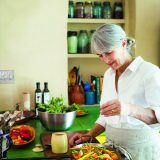For many people, the notion of how wine is made boils down to something like this: A winemaker harvests a crop of one variety of grapes—say chardonnay or merlot—which he (or she) then takes into a cellar, crushes, ferments and matures, then sells under his own label. This of course happens, but it’s really just the barest sketch of how things are really done.
In reality, most properties that farm grapes for their own label will have a diversity of fruit sources. There may be more than one variety planted, for example, and multiple plots each with a somewhat different exposition, soil type, drainage, etc. Holdings might be contiguous (which is how we tend to think of a wine estate) but are equally or perhaps more likely to scattered here and there. Often, a single winemaker is working with some vineyards she owns and some she rents, or with some fruit that she grows herself and some she purchases from a neighbor. We can’t go into all the possible permutations.
When winemakers work with distinct lots of raw material, the tendency today is to make separate vats of wine out of each and later combine them to make a blended wine. That takes advantage of the differences in the various lots, making a better wine than any individual one might on its own. Because a fermenting vat is called, in French, a cuve, a wine assembled from various lots is called a cuvée (koo-VAY). When you hear or see this term, you know you’re dealing with of this sort. In a recent Milk Steet Radio segment, I poured several wines for Christopher that fit this profile.
Wine 1: 2014 Piaugier Sablet
Sablet is a village in the Cotes du Rhone appellation that gets to put its own name on the label. The standards for winemaking from these cru villages is a bit higher than for generic Cotes du Rhone. It’s normally a little fancier and fetches slightly higher prices. This one is $19 at Formaggio Kitchen Cambridge.
The domaine’s holdings are divided into multiple plots on different soil types: clay with limestone and sand, clay with chalk, sand and gravel. The vines here are 20 to 40 years old. Fruit is harvested and vinified separately, parcel by parcel, giving each vat its own specific character. There are two different grape varieties involved: grenache and syrah. In the southern Rhone, red wine bearing an appellation designation must be made with a prescribed cocktail of varietals. The percentage of each is something the winemaker can decide from year to year. Each may be vinified and matured the same way or differently (some in barrels, some in stainless steel, for example). Each combination of varietals, site-specific fruit and variously matured wine is considered a separate cuvée.
Wine 2: Terres de Causses "Baies Pourpre" Vin de France
Figure-skating competitions feature both compulsory figures and freestyle segments, intended to showcase the sport’s two sides: precise execution of standard technique and self-expression. If Piaugier Sablet is, by analogy, the former, this is the latter—a freestyle wine. It presents one of the most unusual blends of varietals I’ve ever seen: merlot, pinot noir, touriga nacional (a Port grape), petit verdot and 17 percent unnamed. There is no appellation in the world that authorizes a combination of grapes like this. The property is in the French Southwest, sort of ground zero for small, quirky operations. With such a diversity of fruit to work with, any number of cuvées would be possible. This is the one the winemaker decided on.
Wine 3: Jaulin-Plaisantin Chinon “Les Hauts et Les Bas”
So-named because this cuvee is made with fruit from the property’s higher and lower altitude plots: the plateau of Cravant (“les hauts”) and the banks of the Vienne river (“les bas”). The riverbank gravels give fruit and roundness, while the flinty clay from the plateau brings minerality and tension. Part of the blend is aged in a concrete tank to retain a vibrant fruit character, and the rest is raised in older oak barrels. The lots are blended together in tank after one year and aged for another three to six months.
Often, a winemaker will make separate cuvées from his younger and older vines, since these can be very different. In the mind of a winemaker, any difference in either raw materials (site, vine age, varietal) or how the fruit has been processed (free-run juice, press wine, aging medium) can became the basis for a cuvée. In this sense, the individual lots of wine function as ingredients. The cuvée that results is the finished dish.
You might ask if there is any wine at all that doesn’t qualify as a cuvée. Good question. It’s fair to say that any wine that has come about as the result of an artful arrangement of difference constitutes a cuvée—and what distinguishes these various lots can be almost anything. It’s as simple and as complex as that.


